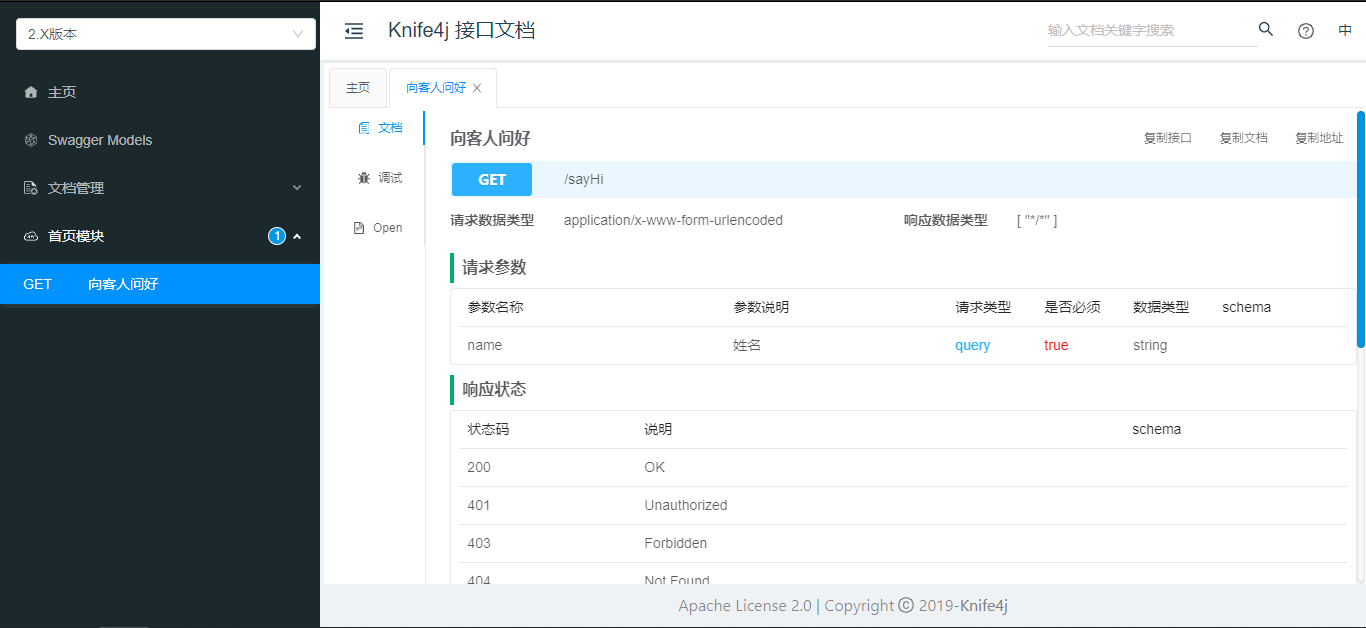热门标签
热门文章
- 1DOMPurify:一个只针对 DOM 的、超快的、宽容的 HTML XSS清理工具_purify.js
- 2Spring Boot 实现接口幂等性的 4 种方案
- 3记录一下hive跑spark的insert,update语句报类找不到的问题
- 45G网络入门基础--5G网络的实现流程_5g附着流程
- 5小甲鱼学python学习笔记_ccc,myqite,cn
- 6【PCIE】基于PCIE4C的数据传输(一)——PC访问FPGA_pcie fpga
- 7新鲜出炉java后端高频面经总结-持续更新中(万字长文,助君青云)_.intern().notify()
- 8keras、tensorflow安装详解-神经网络第一个脚本_比如如果我用keras搭神经网络,应该用什么软件敲代码呢
- 9SpringSecurity从入门到源码分析_spring security源码环境搭建
- 10图解R树的原理及相关操作
当前位置: article > 正文
Spring Boot 框架集成Knife4j
作者:小蓝xlanll | 2024-04-12 07:39:36
赞
踩
Spring Boot 框架集成Knife4j
本次示例使用 Spring Boot 作为脚手架来快速集成 Knife4j,Spring Boot 版本2.3.5.RELEASE,Knife4j 版本2.0.7,完整代码可以去参考 knife4j-spring-boot-fast-demo
pom.xml 完整文件代码如下
<?xml version="1.0" encoding="UTF-8"?> <project xmlns="http://maven.apache.org/POM/4.0.0" xmlns:xsi="http://www.w3.org/2001/XMLSchema-instance" xsi:schemaLocation="http://maven.apache.org/POM/4.0.0 https://maven.apache.org/xsd/maven-4.0.0.xsd"> <modelVersion>4.0.0</modelVersion> <parent> <groupId>org.springframework.boot</groupId> <artifactId>spring-boot-starter-parent</artifactId> <version>2.3.5.RELEASE</version> <relativePath/> </parent> <groupId>com.github.xiaoymin</groupId> <artifactId>knife4j-spring-boot-fast-demo</artifactId> <version>1.0</version> <name>knife4j-spring-boot-fast-demo</name> <description>Demo project for Spring Boot</description> <properties> <java.version>1.8</java.version> </properties> <dependencies> <dependency> <groupId>org.springframework.boot</groupId> <artifactId>spring-boot-starter-web</artifactId> </dependency> <dependency> <groupId>com.github.xiaoymin</groupId> <artifactId>knife4j-spring-boot-starter</artifactId> <version>2.0.9</version> </dependency> <dependency> <groupId>org.springframework.boot</groupId> <artifactId>spring-boot-starter-test</artifactId> <scope>test</scope> <exclusions> <exclusion> <groupId>org.junit.vintage</groupId> <artifactId>junit-vintage-engine</artifactId> </exclusion> </exclusions> </dependency> </dependencies> <build> <plugins> <plugin> <groupId>org.springframework.boot</groupId> <artifactId>spring-boot-maven-plugin</artifactId> </plugin> </plugins> </build> </project>
- 1
- 2
- 3
- 4
- 5
- 6
- 7
- 8
- 9
- 10
- 11
- 12
- 13
- 14
- 15
- 16
- 17
- 18
- 19
- 20
- 21
- 22
- 23
- 24
- 25
- 26
- 27
- 28
- 29
- 30
- 31
- 32
- 33
- 34
- 35
- 36
- 37
- 38
- 39
- 40
- 41
- 42
- 43
- 44
- 45
- 46
- 47
- 48
- 49
- 50
- 51
- 52
- 53
- 54
- 55
- 56
- 57
第一步:在 maven 项目的pom.xml中引入 Knife4j 的依赖包,代码如下:
<dependency>
<groupId>com.github.xiaoymin</groupId>
<artifactId>knife4j-spring-boot-starter</artifactId>
<version>2.0.9</version>
</dependency>
- 1
- 2
- 3
- 4
- 5
第二步:创建 Swagger 配置依赖,代码如下:
import org.springframework.context.annotation.Bean; import org.springframework.context.annotation.Configuration; import springfox.documentation.builders.ApiInfoBuilder; import springfox.documentation.builders.PathSelectors; import springfox.documentation.builders.RequestHandlerSelectors; import springfox.documentation.service.ApiInfo; import springfox.documentation.service.Contact; import springfox.documentation.spi.DocumentationType; import springfox.documentation.spring.web.plugins.Docket; import springfox.documentation.swagger2.annotations.EnableSwagger2WebMvc; @Configuration @EnableSwagger2WebMvc public class Knife4jConfiguration { @Bean(value = "defaultApi2") public Docket defaultApi2() { return new Docket(DocumentationType.SWAGGER_2) .apiInfo(getInfo()) //分组名称 .groupName("2.X版本") .select() //这里指定Controller扫描包路径 .apis(RequestHandlerSelectors.basePackage("com.test.controller")) .paths(PathSelectors.any()) .build(); } private static ApiInfo getInfo() { return new ApiInfoBuilder() .title("xxxxx软件系统") .description("# xxxx是基于 xx平台的新一代 软件系统") .termsOfServiceUrl("http://www.test.com/") .contact(new Contact("mabh","http://www.test.com","test@test.com")) .version("1.0") .build(); } }
- 1
- 2
- 3
- 4
- 5
- 6
- 7
- 8
- 9
- 10
- 11
- 12
- 13
- 14
- 15
- 16
- 17
- 18
- 19
- 20
- 21
- 22
- 23
- 24
- 25
- 26
- 27
- 28
- 29
- 30
- 31
- 32
- 33
- 34
- 35
- 36
- 37
- 38
RequestHandlerSelectors.basePackage 要改成你自己的。
IndexController.java包含一个简单的 RESTful 接口, 代码示例如下:
- 1
此时,启动 Spring Boot 工程,在浏览器中访问:http://localhost:8080/doc.html
import com.test.TabaseWebDemo.Sex; import com.test.TabaseWebDemo.UserModel; import io.swagger.annotations.Api; import io.swagger.annotations.ApiImplicitParam; import io.swagger.annotations.ApiOperation; import io.swagger.annotations.ApiParam; import org.springframework.http.MediaType; import org.springframework.http.ResponseEntity; import org.springframework.web.bind.annotation.*; import springfox.documentation.annotations.ApiIgnore; import java.util.Arrays; import java.util.List; @Api(tags = "首页模块") @RestController public class IndexController { @ApiImplicitParam(name = "name",value = "姓名",required = true) @ApiOperation(value = "向客人问好") @GetMapping(value = "/sayHi",produces = MediaType.APPLICATION_JSON_VALUE) public ResponseEntity<String> sayHi(@RequestParam(value = "name") String name){ return ResponseEntity.ok("Hi:"+name); } @GetMapping("/user") @ApiOperation("获取用户信息接口") public String getUser( @ApiParam(value = "用户ID", required = true) @RequestParam("id") String userId) { // 根据用户ID获取用户信息 return "用户信息:" + userId; } @PostMapping("/user") @ApiOperation("创建用户接口") @ApiImplicitParam(name = "user", value = "用户对象", required = true, dataType = "User") public String createUser(@RequestBody UserModel user) { // 处理用户创建逻辑 return "用户创建成功!"; } // 获取所有 @GetMapping(value = "/users",produces = MediaType.APPLICATION_JSON_VALUE) @ApiOperation("获取所有用户接口") public List<UserModel> getAllUsers() { // 处理获取所有用户逻辑 return Arrays.asList( new UserModel("张三", Sex.man,18), new UserModel("李四", Sex.woman,20), new UserModel("王五", Sex.man,22), new UserModel("赵六", Sex.woman,24) ); } @ApiIgnore @GetMapping("/ignore") public String ignore() { return "这个接口被忽略"; } }
- 1
- 2
- 3
- 4
- 5
- 6
- 7
- 8
- 9
- 10
- 11
- 12
- 13
- 14
- 15
- 16
- 17
- 18
- 19
- 20
- 21
- 22
- 23
- 24
- 25
- 26
- 27
- 28
- 29
- 30
- 31
- 32
- 33
- 34
- 35
- 36
- 37
- 38
- 39
- 40
- 41
- 42
- 43
- 44
- 45
- 46
- 47
- 48
- 49
- 50
- 51
- 52
- 53
- 54
- 55
- 56
- 57
- 58
- 59
- 60
- 61
- 62
- 63
- 64
- 65
- 66
- 67
- 68
- 69
import io.swagger.annotations.ApiModelProperty; public class UserModel { @ApiModelProperty(value = "用户名", required = true) private String username; @ApiModelProperty(value = "性别", required = true) private Sex sex; @ApiModelProperty(value = "年龄", required = true) private int age; public UserModel() { } public UserModel(String username, Sex sex, int age) { this.username = username; this.sex = sex; this.age = age; } public String getUsername() { return username; } public void setUsername(String username) { this.username = username; } public Sex getSex() { return sex; } public void setSex(Sex sex) { this.sex = sex; } public int getAge() { return age; } public void setAge(int age) { this.age = age; } }
- 1
- 2
- 3
- 4
- 5
- 6
- 7
- 8
- 9
- 10
- 11
- 12
- 13
- 14
- 15
- 16
- 17
- 18
- 19
- 20
- 21
- 22
- 23
- 24
- 25
- 26
- 27
- 28
- 29
- 30
- 31
- 32
- 33
- 34
- 35
- 36
- 37
- 38
- 39
- 40
- 41
- 42
- 43
- 44
- 45
- 46
- 47
public enum Sex {
man,woman
}
- 1
- 2
- 3
更多注解使用方法:
https://github.com/swagger-api/swagger-core/wiki/Annotations
界面效果图如下:

声明:本文内容由网友自发贡献,版权归原作者所有,本站不承担相应法律责任。如您发现有侵权的内容,请联系我们。转载请注明出处:【wpsshop博客】
推荐阅读
相关标签




